| |
| |

Paul GAUGUIN was born in Paris in 1848
in a middle-class French family. He was of noble hispano-Peruvian
ascent by his mother, and his family being labelled "liberal" - his
father worked for the organ of the Radical Party, the "National"
newspaper, -, reached Peru in 1849 to escape repression from the "Party
of the order".
His father dies during the travel, and Paul will return
to Paris six years later with his mother and his sister. Of this early
childhood in exile in Latin America , he will always keep a
liking for travel and exoticism.
|
|
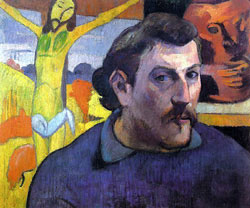
Self-portrait
with yellow Christ
1889

Private Collection
|
 THE SAILOR THE SAILOR
At the age of 17, he engages in the merchant
marine. From this quay of Le Havre where Manet had embarked in
1848, as a sailor, Paul sees in his turn moving away the coasts of
France. The destination is the same one : Rio de Janeiro. By finding
back the continent of his childhood, the young sailor is happy. By the
Magellan Strait, to Port-Famine, Paul goes on his father's grave, then
moves to Panama, Polynesian islands, Indies. There, in 1867, he gets to
know of his mother's death.
 The
STOCKBROKER The
STOCKBROKER
After franco-prussian war of 1870-71, Paul
Gauguin has to start all over again. He will find a job as a
stockbroker employee which he will keep until Stock Market crash of
1882. Gustave Arosa, a friend of his family that had
become his tutor at his mother's death in 1867, will initiate Paul with
painting. Arosa owned an important art collection, including works of
Delacroix. Under his influence, Gauguin will become himself an amateur
painter, then an art collector, buying
Impressionist works.
He meets a young Danish woman, Mette-Sophie Gad,
whom he marries in 1873. She will give him 5 children.
Gauguin who was successful as a stockbroker settles into a comfortable
bourgeois existence.
 THE AMATEUR PAINTER THE AMATEUR PAINTER
|
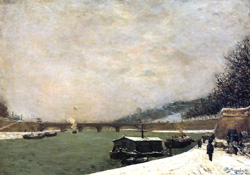
The Seine at the Pont d'Iéna,
snowy weather
1875
Musée d'Orsay, Paris
|
|
With his friend Emile Schuffenecker, a
co-worker and amateur painter too, he will paint in suburbs. At his
beginnings Gauguin painted in the style of Corot, and
will even be accepted at the official Salon of 1876.
In 1874, at Arosa's, he meets Pissarro,
who will initiate him with Impressionist landscape and will give him
the sense of pictorial composition.
He will take part thereafter from 1879 to
1886 in all Impressionist exhibitions, regularly
seeing Pissarro, Manet, Renoir, Degas.
|
| |
During a few years, Gauguin was going to follow in the
wake of Impressionist movement. He will owe it his knowledge of
plein-air light, the luminosity of his colors, and his independence
with regard to conventions.
Throughout his hesitations, one finds his remarkable "Nude
study or Suzanne sewing", which attracted considerable
attention during the Impressionist show of 1881.
The setting and still life character of this painting
point out Manet, the nude study and the sewing daily
gestures betray the realistic vision of Degas, while
the richness of the nuances of light and the blue and green shades on
the naked skin bring this work closer to Renoir.
|
|
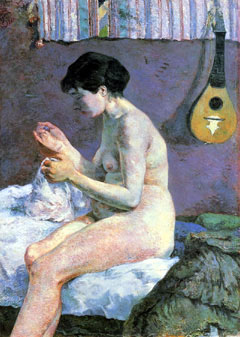
Nude study
or Suzanne sewing
1881
Ny Carlsberg-Glyptotek
Copenhague, Danmark
|
 GAUGUIN FULL-TIME PAINTER GAUGUIN FULL-TIME PAINTER
After the Stock Market crash of 1882, he loses
his job and decides "to paint everyday" and to devote himself to this
art which he had been practising for a long time as a "talented weekend
painter". His wife, without adequate subsistence was forced to return
with her five children to her family
in Denmark.
In July 1886 he accomplishes a first stay in Brittany.
He settles for 3 months at the "Le Gloanec" board and lodging, in Pont-Aven.
There he meets Emile Bernard.
On return to Paris, he meets Van Gogh
for the 1st time in November 1886
|
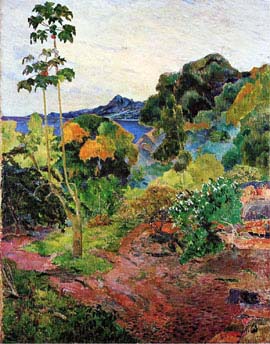
Tropical vegetation, Martinique
1887
Private Collection
|
|
In April 1887, he embarks with the painter Charles Laval
for Panama, from where he will gain Martinique.
He lived there from June to October in a hut on a
plantation, within 2 kilometers from Saint-Pierre.
|
 SYNTHETISM
AND THE PONT-AVEN SCHOOL SYNTHETISM
AND THE PONT-AVEN SCHOOL
On return to Paris, Gauguin will soon set out
again at the beginning of 1888 to Pont-Aven, at the "Le Gloanec" board
and lodging, where he will remain until October, date of his departure
to Arles to paint with Vincent Van Gogh .
| |
In Pont-Aven, Gauguin
gave up Impressionism to work out a new theory, known
as "synthetism".
His research went in the direction of a
simplification of forms, that eliminates details to keep only
essential forms, simplification obtained by use of thick contours and
large flat areas of uniform color, as in his famous paintings "La
belle Angèle" 1889 or "The yellow Christ"
1889.
Gauguin organized a group exhibition of
Pont-Aven painters' works at the Café Volpini, Paris, in 1889, in
conjunction with the World's Fair.
There several of his paintings wake up the
enthusiasm of young painters who soon formed around Gauguin
the School of Pont-Aven.
|
|

La belle Angèle
1889
Musée
d'Orsay, Paris
|
 THE TROPICS' WORKSHOP THE TROPICS' WORKSHOP
In 1891 Gauguin auctioned his paintings to raise
money for a new voyage. The purchase by Degas of his
painting "La belle Angele" allows Gauguin to leave this same
year for Tahiti in order to flee "France civilized
with excess" and “everything that is artificial and conventional” and
to try a new experiment in the Tropics.
|
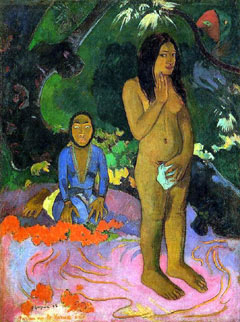
Devil's words
1892
National Gallery of Art
Washington DC
|
|
There he is fascinated by the indolent
charm of local beauties and will paint a paradisiac Oceania (which the
arrival of Westerners had however already largely begun to destroy).
Gauguin then breaks with Western painting
with unmatched freedom and naturalness, moving to a primitive
style with an extraordinary invasion of colors (the purple and
lilac ground of "Devil's words", the yellow
wall behind the "Girl with a mango".
|
Illness forced him to return to Paris in 1894,
where he will be disappointed by the mixed reception Parisian art
critics give to his paintings from Oceania, and sets off again
definitively to Tahiti in 1895.
Over there, loneliness and material distress will
not prevent him from carrying out some of his more beautiful works
where he retranscribes with concision and intensity his
sensual and mystical vision of life .
His masterpiece there was the monumental
allegory "Where Do We Come From? What Are We? Where Are We
Going?" (1897, Museum of Fine Arts, Boston),
which he painted shortly before his failed suicide attempt in january
1898.
In 1901 the artist moved to the Marquesas Islands. It is in his hut
baptized the "house of enjoying" that he died on May 8, 1903 in Hiva
Oa, one the Marquesas Islands.
"Color which is vibration just as music",
these words of Gauguin illustrate the so particular use he makes of
pink, his increasingly sharp love for indigo and lemon-yellow, the
depth of his ocher-colored reds, the wavering of green from
high-pitched to bass tones, his dark harmonies, almost dull, torn by
dissonances. One feels a desire to listen painting sound with all its
power. One is amazed by it, one lets it sink in, one enjoys it.
A major retrospective of his work was held at
the Salon d'Automne in Paris in 1906.
The work of Paul Gauguin will strongly
influence the Nabis and the Fauves .
|

